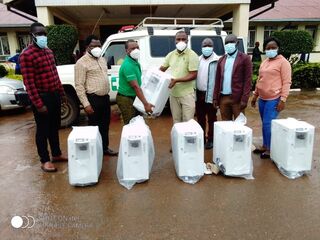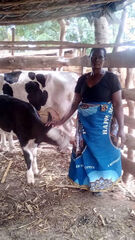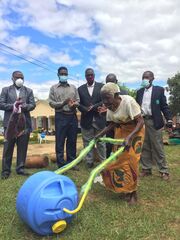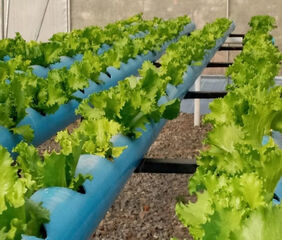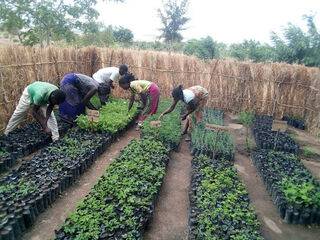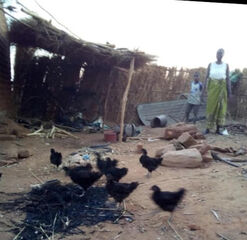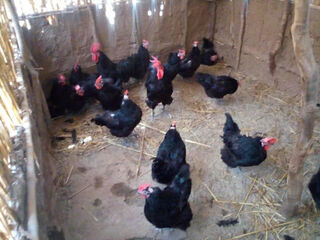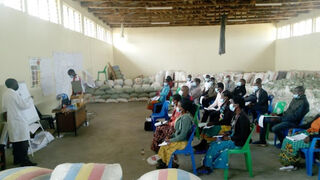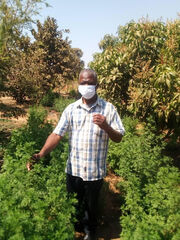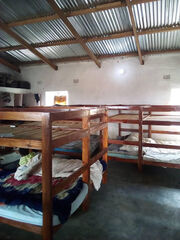November 20, 2021
Dear Friends of Bridges to Malawi,
Well it’s time for my annual update on what we’ve accomplished coupled with our annual appeal for money. I hope you are all well and vaccinated. I want to thank all of you for your past support and belief in what we’re doing. Because of you, we have helped tens of thousands of people in the Kasungu East District of Malawi have a better, healthier life as well as hope for a brighter future. Through your efforts our 2011 single medical mission trip nonprofit has evolved into a development agency with over 20 programs. In the interest of not losing the audience, I will only describe at length some of these programs in this letter, but suffice it to say that all of our projects did well in 2021, COVID notwithstanding.
COVID-19 RELIEF
- Like the rest of the world, Malawi suffered from COVID-19. As some of you may know, Peter Minjale, our most important associate in Malawi and head of our sister organization K2TASO, got very sick from COVID in February and ended up in what passes for an ICU at Kasungu District Hospital (KDH). Fortunately, Peter recovered and is fine now. COVID killed several of Peter’s friends and healthcare colleagues, however. The Delta variant proved to be as terrible there as in the US. Overall, as of Nov 6, 2021, there have been 61,803 officially reported cases and 2302 deaths. This represents a lower percentage of the population infected when compared to the US (0.3% vs 14%, if you believe the numbers), but over twice the mortality rate (3.7% vs 1.6%). Because the government was overwhelmed, they asked K2TASO to take the point on fighting COVID in the Kasungu East District, and K2TASO asked us to help.
- To this end we spent $31,600 for the purchase of 6 oxygen concentrators, mask making and distribution, PPE, COVID 19 public education and outreach, and handwashing stations All told Peter says about 170,000 people benefitted from our efforts.
- Prior to our purchase, KDH had a few oxygen concentrators, but they were capable of producing only 2 liters per minute flow. The 6 oxygen concentrators we purchased for KDH can each produce 10 liters per minute flow each. Most patients with low oxygen levels due to COVID require 15-20 liters/minute to survive. Because of our efforts and your generous donations, by hooking up 2 machines in tandem, the KDH healthcare workers could generate this level of oxygen flow, and thus saved many lives.
- Because COVID has been such a big problem in the US and Malawi in 2021, we have thus far not been able to travel back to Mtunthama. As of this moment (Nov 15 2021) there has, unfortunately, been a slight uptick in COVID 19 cases in Malawi. We hope this is only temporary, but vaccination rates are low there, (only 3% to date) in large part due to lack of availability combined with vaccine hesitancy. Despite this we earnestly hope that things will change for the better soon.
MEDICAL MISSION TRIP
- Because of COVID we did not have a medical mission trip in 2020 or 2021. We hope to resume our high school contest in January of 2022 and our medical mission trip in April of 2022, COVID permitting.
DAIRY PROJECT
- To date 17 of the initial 30 heifers that we purchased have calved with a resultant 9 female and 8 male offspring. All of these animals were impregnated by artificial insemination techniques introduced by us and funded by a single generous donor. In our next round of insemination, we will begin to use gender specific semen, which will increase the likelihood of a female offspring to 85-90% from the current 50%.
- The cows are producing an average of 13 liters of milk per day. Before we had introduced the Holsteins and Friesians to the area as part of our dairy project, the local farmers, if they could afford a cow, used Zebus as a source of milk. Zebus only produce an average of 1.5 liters of milk/day. The average per capita 2021 income in Malawi is $539. Milk can be sold for about 74 cents/liter. A cow will only produce milk for about 300 days a year. This means that our dairy cow beneficiaries will make about $2550 a year beyond what a Zebu would have provided for them. In other words, we have almost quintupled their income. Imagine all of the consequent benefits to their families in terms of improved nutrition, education opportunities, enhanced economic ability and a much more secure future.
- What would it be like for any of us if someone could give us the resources so that, through our sweat and hard work, we could quintuple our annual income? That’s what you’re helping us do in Malawi!
- We are currently awaiting the arrival of a 2000 liter milk chilling tank and a milk pasteurizing/processing system from Antwerp and China respectively. Once these arrive, we hope to help our dairy cooperative beneficiaries as well as our own demonstration project sell milk directly to consumers. The plan is, in 2022 or 2023 to make our Kadsikizi dairy project self-sustaining. We intend for this “best practices” farm to ultimately become a sort of agricultural college. To this end, the Malawi government is already sending veterinary students to visit us and learn from what we’re doing.
- We are not, however, finished yet with the project. We are in the process of buying a total of 30 more Holsteins or Friesian heifers to add to our herd this year. Each cow costs $500 and we could certainly use your help reaching our goal.
- Next year we hope to add a yogurt processing system as well.
- It is also our hope in the next few years to provide milk for free to kindergarten and elementary school students on a daily basis. We will need a partnership with the government, some other NGO, or a very generous benefactor to make this happen at scale, but we believe it’s doable.
- A typical beneficiary of our dairy project is Ms. Mary Jana, a widow at Chamwavi, who was so poor prior to receipt of a dairy cow from us that her two children had to drop out of secondary (middle/high) school because she could not pay the necessary fees. Now, however, since her cow has calved, she is getting enough money from the sale of milk (at least 14liters daily) that her children have been able to return to school.
WELLOS
We have now given away almost all of the 700 Wello waterwheels we had shipped from India in a process that began in 2020. These Wellos make it possible for people to transport the water they need to survive from source to home by pushing a 13-gallon containerful rather than carrying it. They are a big hit! We also realized that they will make excellent physical therapy devices for the elderly. We still hope to find a way to manufacture Wellos in Malawi, but so far have had little success in convincing the Indian company which makes them of the need for a plant in Africa.
HYDROPONIC SYSTEM
As a result of a single donation of $10,000, we were able to construct a 24×30 foot greenhouse solar powered hydroponic demonstration project in March of 2021. It has proven very successful in the production of lettuce so far. 483 heads of lettuce and 226 of spinach from seedling to market in 4 weeks. The local farmers are very interested in this technology which requires a small fraction of the land, water and time needed to grow the same crop than in a traditional agricultural fashion. Our K2TASO partners are now in the process of trying other crops and determining what is the best fertilizing hydroponic solution recipe to use. They are also working on the best sized system appropriate for a small group of farmers. Our donor has already pledged more money for these smaller systems. We hope to keep these hi-tech systems as appropriate as possible for local Malawian farmers in terms of the resources needed to keep them running well.
We also hope to initiate our first aquaponic system in 2022.
REFORESTATION
This year we are on track to plant 250,000 tree seeds. Since the inception of our program a few years ago, we have succeeded in planting 210,000 trees (which have survived) in 52 villages! If you’re worried about global warming and feel you can’t do anything about it, think again! $6,350 buys the planting of 250,000 tree seeds.
CHICKEN PASS ON PROGRAM
- Since 2019 we have donated 790 chickens which means we are providing extra protein and income for about 90 families, a total of approximately 630 people so far.
- We purchased an incubator and built a brooder building in 2021 with plans to purchase and hatch 600 eggs soon. When the chicks hatch and are old enough, we will donate them. The incubator and brooder will bring our costs down significantly from about $5 per chick to about $2 an egg.
COMMUNITY ANIMAL HEALTH WORKERS
In 2021 we paid for the education of 18 community animal healthcare workers as well as the medications and some of the supplies they will need at a total cost of $6600. These individuals will provide much needed help in improving and ensuring the health of all the farm animals in the Kasungu East District.
WATER CHLORINATION
This year we began to chlorinate the drinking water of 150,000 people during the entire 6 months of the rainy season, when diarrheal illnesses become rampant due to the absence of human waste treatment infrastructure. The resultant suffering and death from disease (most often in the very young) is both annually predictable and also completely preventable. The amazing thing is that we will only have to spend about $12,300 a year to protect all 150,000 people for the entire 6 months.
SCHOOL SOLAR POWER & LAPTOP PROGRAM
In 2021 we spent $7400 to upgrade the solar power systems in the 7 secondary schools we already had installations in AND also solar powered another secondary school as well as a primary school for the first time. Children in the newly powered primary school, which is in the town of Tchesa, are now able to study after dark at the school for the first time ever, and they are happily taking advantage of the opportunity. There is no electricity in the area otherwise, and local families are too poor to afford to pay for fuel for illumination at night, so study had to occur during the day and was limited by competition with chores, BUT not anymore! These elementary school students will also have laptops as soon as we can get them there!They will also have laptops as soon as we can get them there!
MICROCREDIT BANK
We spent $538 to help 20 of our beneficiaries whose new businesses suffered from COVID related lockdowns. We did not want anyone we had helped raise up from poverty sink back into it because of the pandemic. Otherwise this very successful project continues to make small amounts of money available to any women’s group with a viable business idea and plan. In 2021 we have given out 214 loans to groups of 8-10 women. 183 of these loans (85%) have been paid back to date.
BAMBOO
Approximately 65% of the bamboo we planted has survived and is doing well. We planted in a total of 14 villages, and the bamboo is thriving in 8 of these, where the soil is most conducive to their growth. Some of our oldest plants are over 12 feet high now. Obviously there is a learning curve here with regard to necessary soil characteristics for the particular bamboo species we have planted thus far. So future efforts will involve more careful soil selection (less clay and more sand based) as well as possible introduction of other bamboo species. Currently our colleagues are learning how to propagate the bamboo, but we will probably need to buy more seed or seedlings in 2022.
ARTEMISIA
Artemisia is now being grown in 53 villages and 3 large tribal areas, all over the Kasungu East District, with a resultant significant drop in malaria rates because of the prophylactic anti-malarial benefits of drinking tea made from this plant’s leaves.
BEEKEEPING
We hope, with your help, to start a beekeeping/honey production initiative in 2022.
IRRIGATION
Although we have drilled 7 boreholes since we began our program, we did not drill any this year. Having said that, we currently have a partnership with William Kamkwamba’s non-profit, Moving Windmills, which need assistance in drilling and solar powering boreholes.
LAND LEASE
In 2021 we enrolled 743 farmers into this program, which gives a group of the poorest farmers a small monthly allotment for a year. To help improve their circumstances in a good year and allow them to stay on their land in a bad one. The average group of 10 farmers receives $140 annually.
COWS AND PLOUGHS
Our initial donated herd of 24 Zebu cows has now increased to 47, and the farm groups that own them are thriving. We inseminated 3 of our zebus with Holstein or Friesian semen with 3 calves resultant. We hope that female calves produced this way will be able to provide increased milk production when compared with their Zebu mothers. If so, this will be a much cheaper way to increase milk production locally when compared with our dairy project, but with an expectation that these cows will be able to produce only 1/2 to 1/3 of the amount of milk our dairy project purebred Holsteins or Friesians can yield. We hope to cross breed at least 100 Zebus (cows and ploughs and those belonging to other farmers as well) as part of this program. If we succeed, this will significantly improve nutrition in the benefitting farm families, while also increasing the amount of cash in their pockets.
This year we also donated 4 more Magoye Rippers to add to the 5 already part of our program. After initial hesitancy because of enhanced crop yields, the farmers now believe in the Rippers and the other conservation agriculture techniques we have asked them to implement.
CHAMBWAVI GIRLS’ DORM
This year we paid for the construction of 12 beds for the secondary school girls’ dorm we built in Chambwavi in 2019 at a cost of about $100 per bed. We will need a total of 90 altogether, so 78 to go!
To summarize, as you think about helping us on Giving Tuesday, or anytime your generous tax- deductible donation of:
$100 will purchase a bed for the Chambwavi girls’ dorm
$200 will chlorinate the drinking water of 2,500 people for the 6 months of the rainy season, protecting them from life-threatening diarrheal illnesses.
$300 will buy 600 eggs and help provide protein, income, and fertilizer for about 70 farm families, approximately 490 people.
$500 will purchase a Holstein or Friesian dairy cow for a single farm family and quintuple their income. The first born of this cow will be donated to another farm family and so on, magnifying your gift tremendously over time.
$2,000 will help solar power a primary school so that students can study at night because the school will be lit up, but also so that we can donate laptops, enabling these students to acquire 21st century tech skills (almost at the same age as our children), opening up vast economic opportunities for them.
I also want to reiterate that 100% of your donations goes towards our programs. Our Bridges to Malawi board/staff is voluntary and we pay all administrative costs. Thanks so much for all of your support in the past and in advance for all your donations this year! We wish you a Happy Holiday Season and a safe and COVID free 2022!

